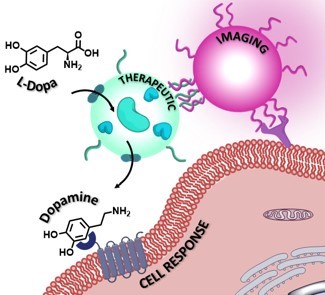Polymersome clusters for advanced nanotheranostics
Nanotheranostics is an emerging field that brings together nanoscale-engineered materials with biological systems providing a combination of therapeutic and diagnostic strategies. However, current theranostic nanoplatforms have serious limitations, mainly due to a mismatch between the physical properties of the selected nanomaterials and their functionalization ease, loading ability or overall compatibility with bioactive molecules. Herein we propose a new nanotheranostic system based on nanocompartment clusters composed of two different polymersomes linked together by DNA. Careful design and procedure optimization resulted in clusters segregating the therapeutic enzyme human Dopa decarboxylase (DDC) and fluorescent probes for the detection unit in distinct but colocalized nanocompartments. The diagnostic compartment provides a twofold function: trackability via dye-loading as the imaging component and the ability to attach the cluster construct to the surface of cells. The therapeutic compartment, loaded with active DDC, triggers the cellular expression of a secreted reporter enzyme via production of dopamine and activation of dopaminergic receptors implicated in atherosclerosis. This novel two-compartment nanotheranostic platform is expected to provide the basis of a new treatment strategy for atherosclerosis, to expand versatility and diversify the types of utilizable active molecules, and thus by extension expand the breadth of attainable applications.

Fig. 1: Schematic illustration of cell attachment of DNA-zipped theranostic polymersome clusters composed of two distinct compartments: the therapeutic DDC-Ncomp and the imaging Dye-Ncomp. While Dye-Ncomps contain fluorescent DY-633 dyes, the DDC-Ncomp contain biologically relevant DDC enzymes that convert L-Dopa into Dopamine. This latter bioactive compound is received by cells and triggers gene expression resulting in the production of a detectable SEAP reporter enzyme.